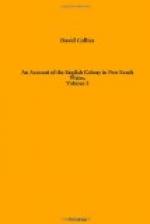Towards noon the coast began to rise into chains of lofty mountains, which ran along in nearly the same line as the coast. The latitude was 43 degrees 07 minutes, the longitude 145 degrees 42 minutes. A large smoke that got up astern of the vessel was the first sign of inhabitants that had been seen upon this west coast, the appearance of which was miserably barren.
On the morning of the 13th they found that they had been carried in the night to leeward of a break in the land, which had been seen the preceding evening, and had the appearance of being the entrance to a harbour. The north point of this imaginary inlet was named Point St. Vincent. The coast here trended to the eastward, the land of which was mountainous and steep to the sea. Some islands were in sight ahead, lying near the land.
At 8 in the evening they passed the SW cape of Van Diemen’s land, hitherto known as that of New Holland. It is a narrow piece of land, projecting from the higher land at no great distance, with two flattish hummocks, that gave it some little resemblance to the Ram Head near Plymouth. Having passed the Cape, they hauled up, and went between the islands, which are De Witt’s Isles, and the main. At sunset they were about a mile and a half from the South Cape.
The south west and south Capes lie nearly east and west of each other, and are distant about fifteen leagues. The intermediate coast forms the southern boundary of Van Diemen’s land; but if taken upon the more extensive scale of the whole southern hemisphere, it appears, as the south point of New Holland, to be of equal respectability with the extremity of Terra del Fuego, and of the Cape of Good Hope, the south points of the continents of America and Africa.
The relative situations of these three points, when viewed upon a chart drawn on the plane of the equator, or upon an artificial globe, are particularly striking. They will be found to lie at nearly equal distances from each other in the circumference, and each extending itself so directly towards the south, that, if continued on in the same line, they would certainly meet somewhere near the pole. The effect that is produced upon the whole globe, by this peculiar disposition of three of its most prominent points, seems indeterminable.
Like that of Terra del Fuego, the extremity of Van Diemen’s land presents a rugged and determined front to the icy regions of the south pole; and, like it, seems once to have extended further south than it does at present. To a very unusual elevation is added an irregularity of form, that justly entitles it to rank among the foremost of the grand and wildly magnificent scenes of nature. It abounds with peaks and ridges, gaps and fissures, that not only disdain the smallest uniformity of figure, but are ever changing shape, as the point of view shifts. Beneath this strange confusion, the western part of this waving coast-line observes a regularity equally




